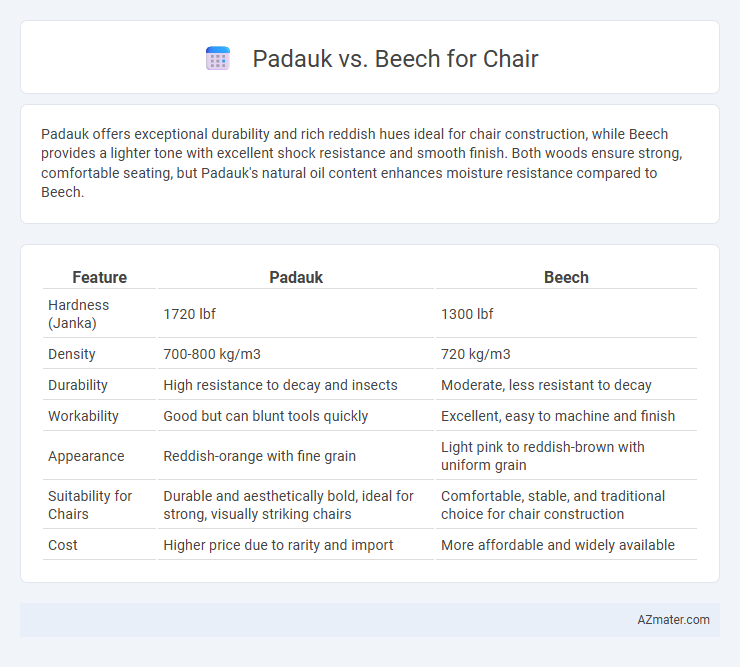Padauk offers exceptional durability and rich reddish hues ideal for chair construction, while Beech provides a lighter tone with excellent shock resistance and smooth finish. Both woods ensure strong, comfortable seating, but Padauk's natural oil content enhances moisture resistance compared to Beech.
Table of Comparison
| Feature | Padauk | Beech |
|---|---|---|
| Hardness (Janka) | 1720 lbf | 1300 lbf |
| Density | 700-800 kg/m3 | 720 kg/m3 |
| Durability | High resistance to decay and insects | Moderate, less resistant to decay |
| Workability | Good but can blunt tools quickly | Excellent, easy to machine and finish |
| Appearance | Reddish-orange with fine grain | Light pink to reddish-brown with uniform grain |
| Suitability for Chairs | Durable and aesthetically bold, ideal for strong, visually striking chairs | Comfortable, stable, and traditional choice for chair construction |
| Cost | Higher price due to rarity and import | More affordable and widely available |
Introduction to Padauk and Beech Wood
Padauk wood, known for its striking reddish-orange hue and exceptional durability, is a popular choice for high-end furniture, including chairs, due to its natural resistance to wear and insect damage. Beech wood features a fine, tight grain with a pale cream color that darkens to a rich reddish-brown over time, offering stability and a smooth finish ideal for comfortable and sturdy chair construction. Both hardwoods provide unique aesthetic and functional qualities, with Padauk favored for bold, vibrant designs and Beech prized for its classic, versatile appearance.
Origin and Availability
Padauk wood originates primarily from tropical regions in Africa and Southeast Asia, including countries like Myanmar and Gabon, known for its rich reddish-orange hue and durability. Beech wood is sourced mainly from temperate regions in Europe, particularly Germany and France, prized for its light color and fine grain. Availability of Padauk is more limited and often considered exotic, resulting in a higher cost, while Beech is widely available and commonly used in furniture production, making it a more economical choice for chairs.
Physical Appearance and Color
Padauk features a rich, vibrant reddish-orange hue that deepens to a warm, reddish-brown over time, offering a striking and exotic appearance for chairs. Beech displays a pale cream to light reddish-brown color with a fine, consistent grain pattern, providing a more subtle and uniform look. The contrast between Padauk's bold coloration and Beech's soft, muted tones greatly influences the aesthetic choice in chair design.
Hardness and Strength Comparison
Padauk wood exhibits higher Janka hardness ratings, typically around 1,410 lbf, compared to Beech, which averages near 1,300 lbf, indicating greater resistance to wear and denting. In terms of strength, Padauk has superior bending strength and stiffness, making it more suitable for durable chair construction that withstands heavy use. Beech offers good strength and shock resistance but falls slightly behind Padauk in load-bearing capacity and long-term structural integrity.
Workability and Machinability
Padauk offers excellent workability due to its straight grain and moderate density, allowing for smooth cutting and shaping with minimal tool wear. Beech is highly machinable, known for its uniform texture and hardness that holds detail well during routing and sanding processes. Both woods perform well in chair construction, with Padauk providing vibrant color and Beech delivering strength and ease of finishing.
Durability and Resistance to Decay
Padauk wood offers exceptional durability and natural resistance to decay, making it highly suitable for chair construction in environments prone to moisture and pests. Beech wood provides good strength and stiffness but is less resistant to decay, often requiring protective finishes to enhance longevity. The natural oils in Padauk contribute to its superior resistance, while Beech is preferred for its smooth finish and workability, though it demands more maintenance for long-term durability.
Comfort and Weight Considerations
Padauk wood offers a dense, durable structure providing firm support and excellent weight-bearing capacity for chairs, enhancing longevity and stability. Beech wood, known for its fine grain and moderate density, delivers a balanced combination of comfort and lightweight properties, making chairs easier to move without compromising on strength. Considering weight and comfort, Padauk tends to be heavier and sturdier, while Beech ensures a more ergonomic seating experience through its lighter, slightly more flexible nature.
Finishing and Maintenance
Padauk wood offers a rich, reddish-orange hue that deepens over time, requiring periodic oiling to maintain its vibrant finish and prevent dullness. Beech, with its pale, creamy color, accepts stains and finishes uniformly but benefits from regular polishing to preserve its smooth surface and resist moisture. Both woods demand careful maintenance to prevent surface wear, though Padauk's natural oils provide slight resistance against drying out compared to Beech's more porous grain structure.
Cost and Value for Chair Making
Padauk offers a rich reddish hue and exceptional durability for chair making, often priced higher due to its exotic nature and density, which ensures long-lasting furniture. Beech wood is more affordable and widely available, featuring a light tone and fine grain that supports smooth finishes and comfortable seating. For cost-effective chair production with solid value, Beech provides a balance of strength and price, while Padauk stands out for premium, visually striking designs with higher investment.
Which Wood is Better for Chairs?
Padauk offers exceptional durability and vibrant reddish-orange hues, making it ideal for chairs that demand both strength and aesthetic appeal. Beech, known for its fine grain and smooth finish, provides excellent workability and comfort but is slightly less resistant to wear and moisture compared to Padauk. For long-lasting, visually striking chairs, Padauk stands out, whereas Beech is preferred for traditional styles requiring ease of crafting and a lighter, neutral tone.

Infographic: Padauk vs Beech for Chair
 azmater.com
azmater.com